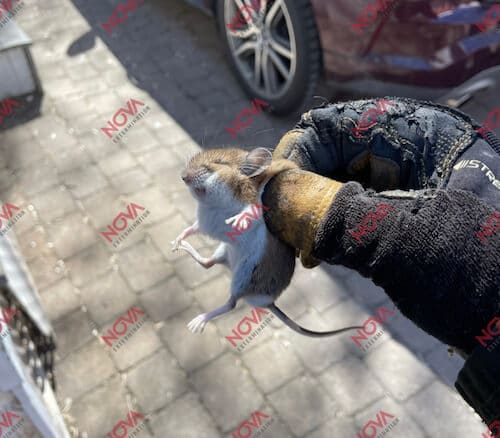Home » Exterminations » Rodents » Field mouse
Exterminate field mice and caulk their entry points!
Would you like to find an experienced exterminator to carry out an extermination of field mice – also called meadow mouse, or vole – on the South Shore? Nova Extermination’s specialized technicians solve your field mouse problem quickly and safely. We offer an affordable field mouse capture and extermination service in all cities on the South Shore of Montreal.
Field mice don’t have only one name! And yes, because of their great diversity of living in different places, we can give them all these names: vole, meadow mouse, earth mouse, wood mouse, jumping rat, ordinary mouse, grey mouse, or even deer mouse
Extermination of field mice on the south shore
Unlike the other field mice exterminators on the South Shore, we do not just perform the extermination of field mice. If you wish, we prevent their return in an efficient and sustainable way!
ENTRY CAULKING PREVENT INFILTRATION OF MULOTS
Field mice can enter your home, to warm, build their nests and steal your food. They do this through small holes or slits around windows and doors. The junction between the roof and the wall of the house is the most common area for field mice. They also thread through chimneys, air vents, plumbing vents, and soffits that protect the attic. This allows a field mouse (also called vole or meadow mouse) to fit into a hole the size of a dime. It can therefore easily nest in your habitat to reproduce.
CLOGGING THE FIELD MICE (VOLE or MEADOW MICE) ENTRY POINTS
Our team is plugging these entry points to stop field mice infiltrating your home. We tour your home and inspect all potentially risky places. Indeed, we go up on the roof to put protective grilles on the chimney hole, the plumbing vents, and the roof ventilator. An inspection of the soffits is also carried out. We replace them if there is an opening through which field mice can enter the attic.
Nova Extermination has a valid license from the Régie du Bâtiment du Québec (RBQ: 5734-75930-01) for your extermination of field mice. Our team also has a CNESST license to perform the necessary caulking work. We are also protected by full liability insurance to perform this work.
Although less numerous than mice, field mice are still an invasive species, especially when looking for food. Indeed, field mice do not live near humans, but in difficult times, they will not hesitate to infiltrate your home to survive.
It is important to learn about this rodent before having a community in your home.

The field mouse is very versatile when it comes to the food it can ingest. They love everything that has to do with cereals and are very fond of buds. It gnaws the shells of these fruits or nuts, eating the larvae, worms or insects that are in them. They may also eat mushrooms or snails. No matter where the field mouse is found, it will be satisfied with any food within its reach. It is therefore extremely harmful to farmers because it is the most easily accessible food for them.
Although the field mouse is versatile when it comes to food, it is also for its habitat. We can find it everywhere! The field mouse can live up to an altitude of 2500 meters. It can be found in the mountains, in the forest, in parks with lots of greenery and in our gardens.
The field mouse will live where it has a shelter, what attracts them to residential areas are hedges because they can easily hide and be covered from bad weather and predators. The field mouse will like to enter your home for the warmth and easy food. They often hide in the attic
Field mice do not like change, which greatly reduces their life expectancy. They generally live between 6 to 12 months but can reach 3 or 4 years for the most robust! Field mice proliferate quickly, a female can give birth to more than 50 young during her lifetime, as she can have up to 4 litters per year and can have between 4 to 9 young. They spread quickly knowing that at only 21 days old, the field mouse is already autonomous and 1 month later it can also give birth to young.

Before field mice invades your home, it is important to contact an exterminator at the first sign to avoid an infestation.
If you want to have field mice exterminated from your home on the South Shore, contact our team of specialized technicians. We will capture the field mice and exterminate them quickly.
Nova Extermination is a field mouse exterminator that holds all the necessary permits to capture and exterminate field mice. Our field mouse extermination techniques comply with the regulations of the Ministry of the Environment.

You can contact us by email or by phone at 514-MON-NOVA for a field mouse extermination in a house or in a business. We cover all cities on the South Shore.


Fill in this questionnaire for a free quote.
We guarantee to get back to you within 12h.

